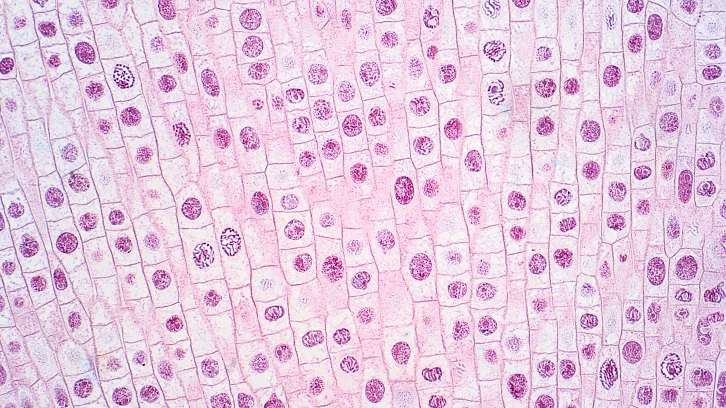New clues to understanding the molecular process of sister chromatid resolution in cell division

A study by the Department of Biochemistry and Molecular Biology at UAB proposes new clues to better understand the molecular processes inside our cells during cell division. The researchers suggest that the bipolar traction forces exerted by the microtubules of the mitotic spindle could induce the sliding of the two chromatin helicoids in opposite directions, thus facilitating the separation of sister chromatids during the prometaphase-metaphase transition of mitosis.
In the nucleus of cells, a molecular process takes place that ensures the correct transmission of genetic information, packaged into chromosomes during cell division. Each human chromosome contains a single copy of an extremely long DNA molecule that is duplicated in the interphase period of the cell cycle. During mitosis each cell divides into two genetically identical daughter cells through several phases: prophase, prometaphase, metaphase, anaphase, and cytokinesis.
At the beginning of mitosis, the resulting pairs of DNA molecules are packaged into chromosomes, which are visible in prophase. During prometaphase, these DNA molecules separate, giving rise to two fully resolved sister chromatids in metaphase. Then, during anaphase, the two microtubule-bound chromatids are pulled to opposite poles of the mitotic spindle (a three-dimensional bipolar network of microtubules) and, finally, cytokinesis produces two daughter cells.
In the living cell, DNA is associated with histone proteins and forms long filaments of chromatin containing thousands of nucleosomes, which are cylindrical particles with nanometric dimensions (11 nm in diameter and 5.7 nm in height) connected to each other by short segments of DNA. Sister chromatid resolution requires the separation of the two chains of duplicated DNA without causing any damage to the original DNA sequence. Moreover, naked DNA and chromatin filaments in solution show a strong tendency to become entangled. Therefore, during DNA replication and sister chromatid resolution, the cell must properly organize the chromatin filaments to avoid intra- and inter-molecular entanglements.
Previous studies in the Chromatin Laboratory (Department of Biochemistry and Molecular Biology) indicated that the chromosome structure consists of many stacked layers formed by the chromatin filament folded as a flat sheet having a thickness of about 6 nm, corresponding to slightly inclined nucleosomes. Considering that this structure is covalently crosslinked with a single DNA molecule in each chromosome, and that several results showed that chromosomes have a helical morphology, we proposed that the chromatin layers form a continuous helicoid within the chromosome. Thus, the absence of intertwining between successive layers of this helicoid may facilitate DNA replication and, presumably, complete replication of the original DNA produces a double helicoid that packs into the chromosome in prophase.This figure schematically represents the hypothesis of the work on the involvement of bipolar forces of mitotic microtubules in the resolution of sister chromatids. Part of the chromatin layers corresponding to the two replicated chromatin filaments in a prometaphase chromosome are represented, respectively, with green and brown nucleosomes (the DNA connecting the nucleosomes of each layer is not shown in this drawing).
In the present work, researchers hypothesized that the traction forces of the bipolar spindle may cause alternating chromatin layers to slide in opposite directions, thus facilitating sister chromatid resolution. This hypothesis is supported by two additional favorable conditions: (1) the orientation (parallel to the stacked layers) of the microtubules is suitable to produce sliding of the layers in opposite directions, and (2) the viscous resistance to sliding caused by weak interactions between nucleosomes in adjacent layers can be overcome by microtubule traction forces.
In contrast to the multiple topological entanglements that can occur in disorganized chromatin filaments, each turn of the double helicoid generates only one topological linkage that can be removed by topoisomerase II (an enzyme abundant in mitotic chromosomes). Then, the spontaneous stacking of all chromatin layers of each chromatid results in the two fully resolved sister chromatids. Furthermore, researchers believe that this mechanism based on the sliding of layers produced by bipolar forces of microtubules and the formation of stable final structures could also be involved in the segregation of recombined homologous chromosomes during the formation of reproductive cells (meiosis).
Joan-Ramon Daban
Department of Biochemistry and Molecular Biology
Faculty of Biosciences
Universitat Autònoma de Barcelona
References
Daban, J. R. (2023) Hypothesis: The opposing pulling forces exerted by spindle microtubules can cause sliding of chromatin layers and facilitate sister chromatid resolution. Frontiers in Genetics, 14: 1321260. https://doi.org/10.3389/fgene.2023.1321260


